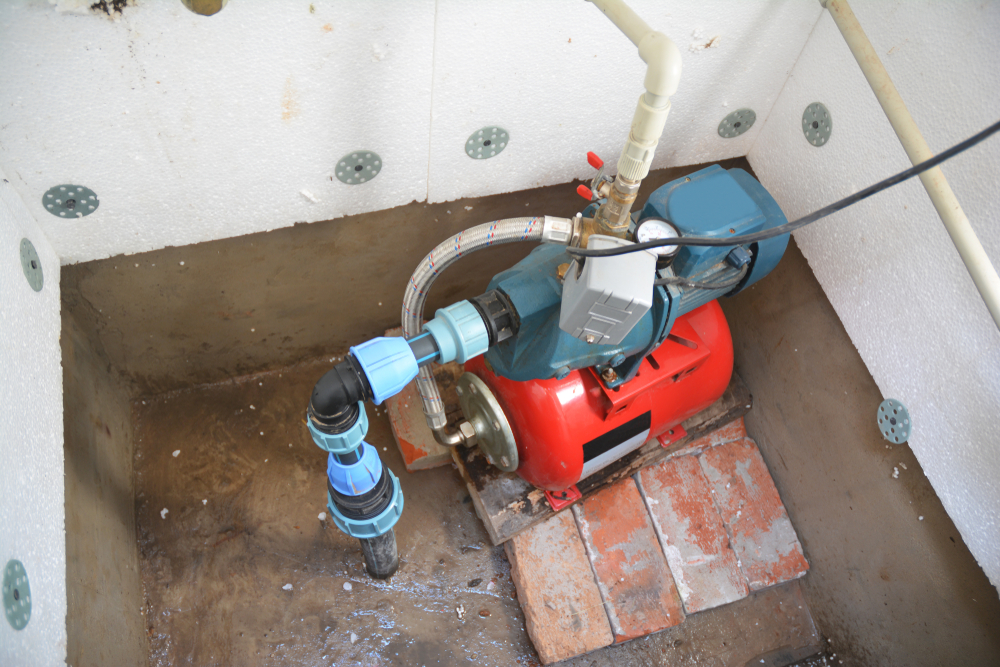Is Your Well Pump Not Working?

Is your well pump giving you issues? If you’re a homeowner of a pump well you know that water tastes best straight from the ground—and of course, love the convenience of having a personal water supply. Like everything in or around your home, your pump well will require maintenance to ensure that it works as it should. Well pumps are essential in providing a continuous supply of fresh water from underground wells. The different types of pumps are:
- Submersible Well Pump
- Jet Well Pump
- Deep Well Pump
- Hand-Operated Well Pump
- Solar-Powered Well Pump
These pumps draw water from the well by either pushing or pulling it, depending on the type. Then, the water is directed to a pressure tank and stored under pressure until the plumbing system is activated, for example, turning on your faucet. Well, pumps will turn on and off automatically based on the air pressure inside the tank.
A malfunctioning well pump can disrupt your access to clean and consistent water, causing inconvenience and discomfort for you and your family. If you notice signs of failure from your well pump or pressure tank, it’s crucial to address the issue promptly to maintain your family’s lifestyle and daily activities.
This blog will cover why your well pump isn’t working, including signs of well pump failure, as well as well pump troubleshooting and replacement options.
Common Signs Your Well Pump Is Failing
- A sudden decrease in water pressure: If you notice a sudden decrease in water pressure in your water pressure tank, then check the pressure switch, as this could cause failure.
- Fluctuating water pressure: When air pressure fluctuates, or there isn’t enough pressure, the signal to the pressure switch to turn the tank on will fail. Check your tank to see if the pressure is 20 psi or higher.
- Air sputtering from faucets: When water spits or spurts from a faucet, then that could indicate failure with the air bladder since its job is to add air into the water.
- Strange noises from the well or pump: Strange noises like constant or rapid clicking noises can indicate that your well pump needs attention. The bearing or moving part within the pump could be wearing out.
- Visible signs of leaks or damage: Visible leaks or damage can allow contaminants to enter the well pump and tank, affecting the water quality.
- Discolored or foul-smelling water: If the water coming out of your spouts has a foul smell, it could mean that your well pump or components within are deteriorating.
Common Reasons for Well Pump Failure
Electrical Issues
Electrical failure or power supply issues are major contributors to well pump failures. These problems often stem from faulty wiring, connections, electrical surges, shorts, or lightning strikes. Even though pumps use a lot of electricity, they don’t run all day. They typically run for only a short period each day. When your energy bill suddenly spikes, it’s most likely due to a leaking or damaged pump that is running continuously or much longer than usual.
Lightning strikes are particularly problematic as they can cause immediate damage or lead to gradual failure over time. Even though a pump may seem to function normally for a week or two after a strike, the wires may eventually fray, resulting in complete failure. Lightning can damage the pump motor and burn the insulation of the wires. Fortunately, homeowner’s insurance may cover the replacement cost if your well pump is damaged by lightning.
Mechanical Failures
The pressure switch at the bottom of your pressure tank needs regular maintenance to prevent failure and ensure access to water. When troubleshooting for mechanical failures, check the pump motor connection first and test the pressure switch. You can do this by removing the protective casing from the pressure switch and giving a hard tap with pliers or a screwdriver to the tube below. If you see a spark, the pressure switch is likely the problem. If the pressure switch is the issue, inspect its electrical circuitry. If it’s in bad condition, replace it to prevent further damage.
Sediment Buildup or Blockages
If sand and silt enter the pump, not only could they end up in your water supply, but they can cause buildup and blockages that prohibit it from functioning properly. If you observe gritty water, it indicates some type of sediment buildup and water contamination. This could occur due to excessive pump power or damaged filters. Sediment accumulation, including dirt, stones, and minerals from hard water, can impair the pump’s performance by eroding its parts and obstructing water flow. Examining the tank will reveal the extent of damage caused by contaminants. Either the pump is oversized, or the filter screen is worn out. In either case, replacing the pump or the screen is likely necessary.
Pressure Tank Issues
Many of the problems that could cause your pump well to not work stem from a malfunctioning tank. In many scenarios, it is cost-effective to replace both the pump and the tank because the tank is the culprit of the issues. To test a system’s tank, homeowners can run the water from any fixture in their home. If the pump kicks on every time the water is running, likely, that the tank isn’t holding pressure.
Well Water Contamination
If your well pump is trying to draw water from shallow depths, it could bring up silt and sand which can contaminate the well water. This occurs during a drought or indicates the necessity for a deeper well. Additionally, excessive rainfall can lead to runoff entering your well, resulting in murky or gritty water. In such cases, it’s crucial to cease water usage immediately and have your well professionally sanitized to prevent contamination from dangerous bacteria present in runoff. If neither drought nor flooding is the issue and sediment persists in your well water, the next troubleshooting step involves examining the pump filter for tears or wear.
Age and Wear
The typical lifespan of a well pump ranges from 8 to 12 years. Some may last longer than others due to water quality, sediment levels, frequency of use, and installation quality. Wear and tear are usually the cause of well pump failure, emphasizing the importance of maintenance and care. Even with proper upkeep, occasional repairs may be necessary to ensure smooth operation.
Well Pump Troubleshooting Steps
Here are some troubleshooting steps you can try at home to check if your well pump is working effectively. Remember, some ways to tell if your well pump is going bad is if there is no water flow from the faucet, poor water pressure, or a constantly running pump.
Step One: Initial Assessment and Observation
Make sure the pump is turned on. If it’s not, switch it on. If it still won’t turn on, check the circuit breaker in the electrical panel. If it’s tripped, reset it. Also, inspect your yard for any flooded areas indicating a broken water pipe between your home and the well.
Step Two: Checking Power Supply and Electrical Connections
Check the voltage, control panel, and splice connections. Verify that the voltage is within +/- 10% of the motor rating. Assess power distribution by measuring voltage at the pressure switch, control box, and other relevant components.
Step Three: Inspecting the Pressure Tank and Pressure Switch
Check the pressure tank and switch. The pressure tank uses air to push water out of the tank and into your home. Ensure adequate air pressure in the tank (20 psi or higher). Low pressure indicates potential electrical or pump issues, requiring professional help.
Step Four: Evaluating Water Quality and Potential Contamination
Sediment present in the well water can significantly deteriorate the pump assembly over time, acting as an abrasive that gradually wears down the pump’s bearings and other parts. Additionally, dirt, minerals from hard water, small stones, and debris can clog the pipes connected to the pump, leading to reduced water flow or complete pump failure.
Step Five: Removing Sediment or Blockages
Ensure to inspect the pressure switch thoroughly. Verify the cleanliness of the nipple or tube connected to the switch for any sediment or debris. Remember to disconnect the power and release all system pressure before conducting the check.
Step Six: Consulting With a Professional if Necessary
Sometimes, doing it yourself or troubleshooting with these steps won’t fix all your problems. In fact, throughout these steps, you may have concluded that you have to call a professional. You should consult with a professional, like the ones at T. Webber, when water still isn’t flowing, there is sediment in the water, or you find broken pipes. These are just a few examples of when it’s time to call a professional. If you’re still concerned about your well pump not functioning properly, call the experts at T. Webber.
How Long Does It Take to Replace a Well Pump?
If installed professionally, a well pump should only take about a day to install or replace. It could go faster or take longer depending on your location, the type of the well pump, and the depth of the pump being replaced. All factors that influence the replacement and installation process for a good pump are the well size and depth, pump type, pump power, and quality, and sometimes pipework and wiring.
A replacement for your well pump takes a highly trained and skilled technician with multiple years of experience. It’s very important to do your research before hiring a professional. You want to make sure that the company is licensed and insured, as well as obtaining the correct certifications and training. A pump well that is installed poorly could lead to pump failure quicker and decrease the lifespan.
Maintain and Fix Your Well Pump With T. Webber
Regularly maintaining your well pump ensures that your home always has running water. That is the most important reason you should maintain your well pump, but it also will increase its lifetime use and prevent damage or water contamination. There are some signs to watch out for in your well pump such as a drop in water pressure, strange noises, or anything else that indicates failure. No matter the issue, our experienced technicians at T. Webber can diagnose the problem and conduct any necessary repairs with utmost care.
We know the ins and outs of maintaining, repairing, or replacing a pump well for residential homes. Call the trusted experts at T. Webber today.




